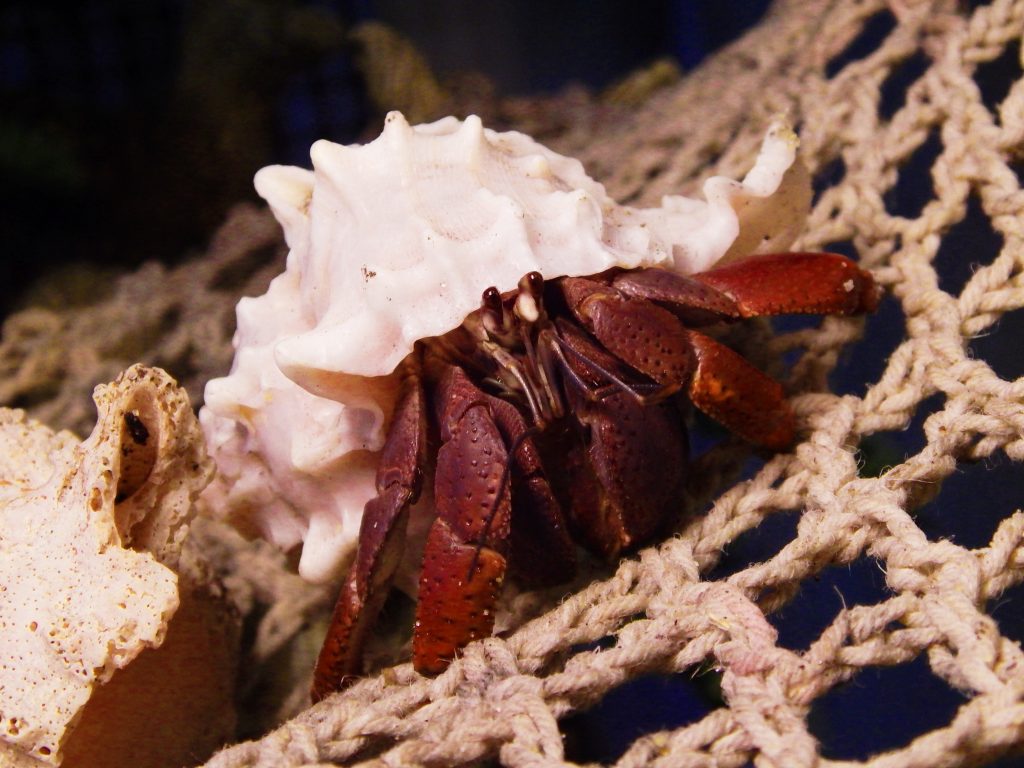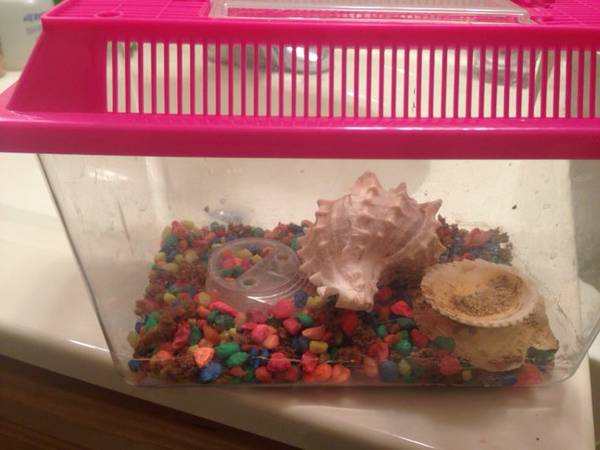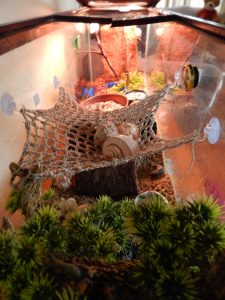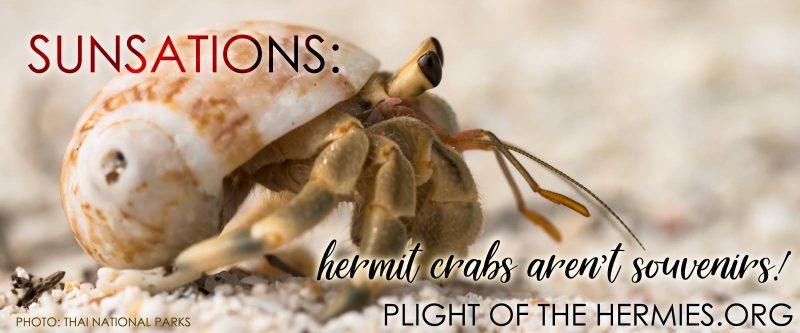At the door of a Maryland townhouse, I stood in the rain as a man thrust a plastic container into my hands. I ran back to the car, dripping, and hopped in. There, we opened the lid—and we were immediately floored by a pungent odor much like that of a fishing pier. I was pretty certain that there wasn’t anyone alive in there.

We’d found her on Craigslist, being offered up for free, and immediately decided to make the 8-hour round trip to bring her home. She’d never make it without swift intervention, we knew. With summer shriveling into fall and the outdoor humidity levels plunging day by day, time wasn’t on this tropical creature’s side. Her modified gills would already be struggling desperately to breathe in the crisp Mid-Atlantic air.
Molasses had been bought earlier that summer by a family visiting a souvenir shop at the beach, but was quickly set aside when boredom crept into their children, whose curious fingers were hungry for their next interactive toy.
For Molasses, though, there was no relief from the boredom in that plastic prison—the isolation, the gloom. There were no branches, no hideaways, no sandy beaches. Nothing for her to do but sit, curled up inside her shell, and rot.
When we first took her in, Molasses was so weak that she could hardly lift up her shell to walk around. We immediately moved her into a much larger tank, filled with stimulating objects, proper food, sea water, high humidity, and warmth—the closest possible habitat we could provide to her natural home, the tropical seashore.
Her rescue was bittersweet. We saw her come out of her shell, figuratively and literally, and begin to explore her surroundings. Her strength grew. Her antennae perked up. But we knew she’d never see the waves on the beach again, or feel the wind blowing through her shell, because, once captured, hermit crabs can never be set free again. Their odds of survival when being stranded on an unfamiliar beach, much like our own, are quite low. So we were simply resigned to do our best.
She was one of five hermit crabs my wife and I rescued between 2011 and 2013, a hodgepodge of characters, all female, who surely had their disagreements and growing pains—marked by rounds of intense clicking—but eventually meshed together like the Brady Bunch. Molasses, or Mo, was the largest of the gang, and she didn’t have any trouble striding in and staking out her own space alongside Stevia, Splenda, Truvia, and Agave.
Hermit crabs like Molasses are complex wild animals who can live for over 30 years in their natural habitat, the tropical seashore. These social beings thrive in large colonies and often sleep piled up together. They enjoy climbing, foraging, and exploring and even work in teams to find food. Once a troupe of hermit crabs was observed stacked on top of one another to orchestrate a heist from a bag of dog food. Those on top were responsible for nabbing the goods and sending them down the line. These clever, sensitive animals will also rub and nurse their wounds when they’re injured—evidence that they, in fact, feel pain like we do.
And hermit crabs have unique personalities, just like Fido. Molasses, the bold adventurer, seemed to calculate each move. She was deliberate, on a mission. Agave, on the other hand, was reserved, cautious, a follower. They complemented one another like yin and yang.
Every single land hermit crab sold in souvenir shops—hundreds of thousands every year—has been caught from the wild, as these animals do not breed readily in captivity. And investigative footage has revealed that to the souvenir industry, hermit crabs are nothing more than disposable trinkets. A shocking investigation of one hermit crab supplier in Florida, for example, recently revealed what happens to many hermit crabs after being ripped from the seashore, before they reach store shelves: They are confined in filthy, crowded warehouses by the thousands and tossed in bags with hundreds of others to be shipped to retailers. Hermit crabs depend on their natural shells for protection, yet in another video, these delicate animals are shown being forcibly shoved into painted shells to be sold to tourists.
Once at the boardwalk, hermit crabs are sold to tourists in tiny, barren cages with some pebbles and maybe a plastic palm tree, if they’re lucky. Deprived of everything natural to them, they are destined to die in mere months. They often spend their short captive lives slowly perishing from suffocation because their modified gills require high humidity to breathe. These crabs also need deep substrate to molt and grow; without it, their bodies will halt the molting process until their death.
If their miserable captive environment doesn’t do them in, their own shells—their basic means of protection—can very well kill them in captivity. Many hermit crabs are slowly poisoned by the toxic paint adorning their shells. They don’t care if they’re pink or purple, but they pay with their lives because we do.
Molasses, Stevia, Agave, Splenda, and Truvia should have lived to be my age: 30 years old. But they didn’t make it more than a fraction of that time. Despite our best efforts, our tank suddenly collapsed in late 2014 for no explicable reason, leaving no survivors—but leaving us behind, absolutely devastated.
I wanted to, but I didn’t falter through my despair. Instead, I decided to turn their plight into a movement: The Plight of the Hermies. Over the last four years, through this project, my community and I have made some incredible strides: Over 50,000 people have signed our petition to get beach chain Sunsations to stop selling hermit crabs. We saw the end of the Mid-Atlantic Hermit Crab Challenge, a terrifying annual “race” marked by crowds and blasting music in Virginia Beach. We’ve gotten media coverage in The Virginian-Pilot and Lady Freethinker and an op-ed in One Green Planet. We helped PETA release the first undercover investigation of this cruel industry, opening millions of eyes.
We’ve shown countless people around the world that crustaceans are sentient, intelligent animals—not souvenirs.
So onward I march, for them. And I will continue to fight for their freedom, year after year, in memory of Molasses and of countless others like her, so that someday their descendants can be left in peace at the seashore instead of the store shelf.
Visit PlightoftheHermies.org to get involved in this important work for hermit crabs everywhere.




A beautiful, sensitive, well-informed piece that will, no doubt, open some eyes and touch many hearts. Kudos to you for your amazing efforts to shed light on the Plight of the Hermies!
I’m a hermit crab owner who never planned on owning these little critters! I live in North FL and was walking my dog by the woods at the edge of our apartment complex when I noticed a beautiful shell that was clearly out of place. I picked it up thinking it would surely be empty and to my surprise there was a hermit crab inside! I have no idea how long the poor guy was left out in the heat with no water but I knew I was his only hope for survival. I’m assuming someone in my apartment complex bought him for their children, realized hermits require a lot more care than they wanted to provide, and dumped him outside. That was 2 years ago and I have rescued 6 other hermies who all live in a 70 gallon tank with proper temperatures, humidity, toys, substrate..etc. It makes me so angry how mistreated and misrepresnted these critters are!
Thank you so much for all your amazing rescue work, Mary!
I was a kid once, i remember going to the beach, i found this cool small black crab on the pier pylons and brought it home. It died after a week, and I felt really bad. As a parent you should learn these things and know some things are meant to be in the wild. I allowed my kids to see and touch all the things at the beach, but it was discussed why we couldn’t bring anything home.
Your work and commitment is fantastic and long may you continue to save these little fellas. I wish you the very best of luck , I will donate when I can( sadly I have to support so many worthy causes)
You are an inspiration to me. You saw suffering where no one else did. You saw life where everyone else saw a commodity. You started this campaign to raise public awareness. You put yourself and your comfort on the line to protest what the hermit crab has been subjected to. I’m 44 and I’m ashamed of not having your kindness and your courage. I wish I ever had a friend like you. I will relay your message to whoever will listen. I cannot thank you and your crew enough!
Stop now !
Hi! I am so touched by this article. I just received a hermit crab from a friend that she bought from a souvenir shop in Florida- exactly The situation you described and are working to change. My daughter loves this precious little creature, as do I. But I’m at a TOTAL loss as to how to keep him alive, happy, and thriving. As much as I hate to admit this, especially publicly, we have very little extra money after all the bills, etc. are paid, which will limit us to the type of environment we can provide for Hermes. I was wondering if you could point us in the right direction of how to care for him/her, and how to give him/her a proper home without spending a lot of money. We would so greatly appreciate the guidance !!!
Hi Ayla,
Thanks so much for reaching out and for trying to take the best care of your hermie that you can! Here is a great guide that should help you: http://www.plightofthehermies.org/adoption-and-care-guide/. Please don’t hesitate to reach out with further questions!
I had 28 hermit crabs. They had an very large fish aquarium with 50 lbs of sand. Two heaters bottles water and salt water I also had day light and light we left on at nite. I misted heavily in the am and little squirts during the day. Fed commercial hermit crab food. But always added fresh fruits and vegetables I also had a Large plastic container that I would mix up tons of warm salt water and let them swim in it every Friday night they seem to thrive from the salt water and loved it but I did keep an old rag in there in case it got too deep they could hold onto the rag good luck with your homey’s they are a lot of fun
I have hermit crabs I rescued from a school the school’s buy them to teach the children but at the end of the year they want to just put them in the freezer and kill the crabs I save their lives and I give them everything I possibly can high humidity coconut bedding very deep for they can malt variety of hermit crab food and fresh food and I tried different things that they may like I give them fresh water and salt water with an air bubble Stone to keep the water moving. they seem to like that a lot I have two left I used to have seven I give them different shells for they can grow they were very tiny now they’re a lot larger so I must be doing something right. I try to make their home as happy as they can be unfortunately it is hard to keep them alive but I will try my best I know they cannot go back into the wild I hope they stop the selling of hermit crabs it’s not fair to them they’re not a toy but a living creature with personality and feelings God bless you for helping hermit crabs and anybody else please pass on word not to buy hermit crabs and let your local pet store know how bad they are treated and not to purchase any more cuz of the horror they go through God bless all the hermit crabs out there. I dedicate this to my two remaining hermit crabs Judy and Alistair.
Thank you so much for rescuing them, Cindy, and for your support!
I am literally crying while reading your article. You are amazing people!
Currently have 4 very happy and spoiled crabs. Heartwarming story.
Im staying with a friend who has a hermit crab. Someone gave it to her. she has had it for about a year. Still in its original plastic container with only color gravel its painted shell water and food bowls bowl. She knew nothing about hermits crabs. With her busy live raising 3 kids and work she would offen forget to feed it. When i fist saw this crab my heart was so sad. I immediately went out and bought it a glass 10 gallon tank, substrate, salt and fresh water bowls. Heating pad for the side of the tank, new shells,wood hideaway and and fake plant for it to climb on. Now i dont know much about these beautiful lovable critters but knew enough to get it started to a better life. My friend grave me the hermit crab after i spent so much money on it. Had it now in my care for about two weeks in his new Environment. About 5 – 6 days ago he has gone under the substrate and has been their sense. My guess is molting and happy to be doing so as he has been unable to in his original container for over a year. I dont mess with him, but do continue to make sure he or she has food and water. I dont smell anything fishy or any bad smells so im assuming he or she is fine. Its bigger than a quarter and smaller than a siver dollar. My question is how long will this molting process take? and is there anything else i should be doing? Other than spend more money on this cute little fella and get a even bigger tank and more clibing toys lol. Please respond back as im new to all this and it killing me not knowing forsure how its doing under the substrate. Than you
Lisa
Lisa, that’s wonderful that you have taken in this crab to care for him! Yes, he is most likely molting, and at this point you’ll just want to maintain tank conditions and disturb the tank as little as possible. He could be down there between 1 and 3 months at most. You can find more specifics about hermit crab care at my other website, http://www.PlightoftheHermies.org. Good luck and thanks for your compassion!